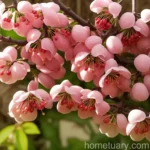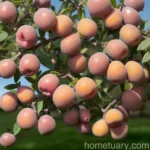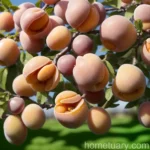Purple-Leaf Sand Cherry (Prunus x cistena): A Plant Scientist’s Guide
What is Purple-Leaf Sand Cherry (Prunus x cistena)?
The Prunus x cistena, commonly known as the purple-leaf sand cherry, is a beautiful ornamental shrub that belongs to the Rosaceae family. This deciduous plant is admired for its stunning purple foliage, making it a popular choice for landscaping and gardens. The purple-leaf sand cherry typically grows to a height of around 7-10 feet with a spread of 5-8 feet, creating an eye-catching display with its dark purple leaves and delicate pink flowers. The scientific name Prunus x cistena suggests that it is a hybrid of two different species within the Prunus genus.
Key Takeaways – Purple-Leaf Sand Cherry (Prunus x cistena)
Before diving into the detailed aspects of the purple-leaf sand cherry, here are some key takeaways that will be covered in this comprehensive guide:
- Scientific Name: Prunus x cistena
- Common Names: Purple-Leaf Sand Cherry, Ornamental Cherry Tree, Sand Cherry Cultivar
- Characteristics: Purple-Leaf Foliage, Pink Flowers
- Cultural Uses: Landscaping, Ornamental Planting
- Growing Requirements: Water, Sunlight, Fertilizer, Soil, Pruning, Propagation
- Popularity: Widely Used in Landscaping and Gardens
- Common Diseases: Anthracnose, Leaf Spot
- Common Pests: Aphids, Caterpillars
- Fun Facts: Interesting Tidbits about Prunus x cistena
- Botanist’s Tips: Expert Suggestions for Optimal Growth
Now, let’s delve into the various aspects of the purple-leaf sand cherry, from its cultural uses to its growing requirements and maintenance.
Culture
Uses
The purple-leaf sand cherry is primarily valued for its ornamental qualities, making it an excellent choice for landscape design and ornamental planting. With its striking purple foliage and delicate pink flowers, it adds visual interest to gardens, parks, and other outdoor spaces. Its versatility is evident in its widespread use as a standalone specimen, hedge, or accent plant.
Water
Proper water management is crucial for the health and vigor of the purple-leaf sand cherry. It is important to establish a watering routine that provides consistent moisture without waterlogging the soil. After the initial planting, regular deep watering, particularly during dry periods, is essential to promote a healthy root system. A layer of mulch around the base of the plant can help retain soil moisture and regulate temperature fluctuations.
Sunlight
The purple-leaf sand cherry thrives in full sun to partial shade, exhibiting its best foliage coloration when exposed to ample sunlight. When selecting a planting location, prioritize spots that receive at least 6 hours of direct sunlight per day. However, it is important to note that the plant can tolerate light shade, particularly in regions with intense summer heat.
Fertilizer
Fertilization plays a crucial role in supporting the growth and overall health of the purple-leaf sand cherry. A balanced, slow-release fertilizer formulated for woody plants can be applied in early spring before the onset of new growth. Additionally, incorporating a layer of organic mulch around the base of the plant not only helps retain soil moisture but also provides a steady supply of nutrients as it decomposes.
Soil
Well-drained, loamy soil with a slightly acidic to neutral pH is ideal for the purple-leaf sand cherry. The soil should be rich in organic matter to support healthy growth and development. Prior to planting, it is beneficial to conduct a soil test to assess the nutrient levels and pH, making amendments as necessary to create an optimal growing environment for the plant.
Pruning
Pruning is an important aspect of maintaining the shape, size, and health of the purple-leaf sand cherry. While the plant has an attractive natural form, periodic pruning can help remove dead or damaged branches, encourage new growth, and enhance its overall appearance. The best time to prune the purple-leaf sand cherry is in late winter to early spring before the emergence of new growth.
Propagation
The purple-leaf sand cherry can be propagated through various methods such as softwood cuttings, hardwood cuttings, and by root division, although softwood cuttings are typically the preferred method for home gardeners due to their higher success rates. The cuttings should be taken from healthy, disease-free plants and rooted under controlled conditions to ensure successful establishment.
Container Popularity
Due to its compact size and stunning foliage, the purple-leaf sand cherry is well-suited for container planting, making it an attractive choice for urban gardens, patios, and balconies. When grown in containers, it is essential to provide proper care and maintenance, including regular watering, appropriate fertilization, and periodic root pruning to prevent overcrowding.
Container Common Diseases
While the purple-leaf sand cherry is relatively resistant to many common diseases, it can occasionally be susceptible to certain issues such as anthracnose and leaf spot. These fungal diseases often arise in conditions of high humidity and poor air circulation, leading to leaf discoloration and lesions. Implementing proper cultural practices and monitoring the plant for any signs of disease can aid in prevention and early intervention.
Disease Diagnosis
Diagnosing potential diseases in the purple-leaf sand cherry involves careful observation of the plant’s foliage, stems, and overall growth patterns. Any abnormal discoloration, spots, or lesions should be thoroughly inspected to determine the underlying cause, whether it be environmental stress, pests, or disease. Consulting with local horticultural experts or extension services can provide valuable insights into accurate disease diagnosis and management strategies.
Common Pests
Various pests may pose a threat to the purple-leaf sand cherry, including aphids, caterpillars, and scales. These insects can cause damage to the foliage, affecting the overall health and aesthetics of the plant. Implementing integrated pest management practices, including regular monitoring, proper sanitation, and targeted insecticide applications as a last resort, can help mitigate pest pressures effectively.
Botanist’s Tips
As a plant scientist, I would like to offer some valuable tips for successfully growing and caring for the purple-leaf sand cherry:
- Soil Preparation: Prior to planting, ensure that the soil is well-drained and supplemented with organic matter to create an optimal growing environment.
- Sunlight Exposure: Position the plant in a location that receives ample sunlight to promote vibrant foliage coloration.
- Pruning Practices: Exercise caution when pruning to maintain the natural form of the plant while improving its overall health.
- Watering Routine: Establish a consistent watering schedule, particularly during dry periods, to support healthy root development.
Fun Facts
Now, let’s explore some interesting and lesser-known facts about the purple-leaf sand cherry:
- The purple-leaf sand cherry is known for its attractive foliage, which undergoes color changes throughout the seasons, displaying shades of purple, red, and green.
- In early spring, the plant produces delicate, pale pink flowers that add a delightful touch of color to the landscape.
- The purple-leaf sand cherry is classified as a drought-tolerant plant, making it suitable for regions with limited water availability.
- This ornamental shrub is known to attract various pollinators, including bees and butterflies, adding ecological value to garden spaces.
Links to External Resources
For further information on the purple-leaf sand cherry (Prunus x cistena), refer to the following resources:
- The Spruce – Purple-Leaf Sand Cherry Profile
- Missouri Botanical Garden – Prunus x cistena
- University of Florida – Sand Cherry Care Guide
In conclusion, the purple-leaf sand cherry (Prunus x cistena) is a captivating ornamental shrub that adds beauty and visual appeal to diverse landscaping and garden settings. With its striking purple foliage, delicate pink flowers, and versatile uses, it remains a cherished choice among plant enthusiasts and landscape designers. By understanding its cultural requirements, common issues, and maintenance practices, one can create an optimal growing environment for this stunning plant, allowing it to thrive and flourish in outdoor spaces.
Plant Name: “purple-leaf sand cherry (Prunus x cistena)”
Keywords:
1. Prunus cistena
2. Purple-leaf sand cherry tree
3. Ornamental cherry tree
4. Purple foliage plant
5. Sand cherry cultivar
6. Prunus x cistena varieties
7. Sand cherry landscaping
8. Purple-leaf flowering shrub
9. Prunus cistena species
10. Purple sand cherry tree
11. Cherry blossom shrub
12. Prunus x cistena care
13. Purple-leaf ornamental tree
14. Sand cherry garden plant
15. Drought-tolerant sand cherry
16. Purple cherry tree
17. Prunus cistena cultivar
18. Sand cherry foliage
19. Prunus x cistena planting tips
20. Purple-leafed cherry tree
21. Sand cherry hedge plant
22. Dwarf sand cherry
23. Prunus cistena landscape uses
24. Purple-leafed flowering tree
25. Sand cherry shrub varieties
26. Prunus x cistena pruning techniques
27. Purple foliage flowering plant
28. Sand cherry tree care
29. Prunus cistena growth habit
30. Purple-leaf sand cherry uses
31. Sand cherry bush
32. Prunus x cistena maintenance
33. Purple-leafed ornamental shrub
34. Sand cherry companion plants
35. Prunus cistena drought tolerance
36. Purple cherry leaf plant
37. Prunus x cistena hardiness
38. Sand cherry landscape design
39. Prunus cistena soil requirements
40. Purple-leafed cherry bush
41. Sand cherry planting guide
42. Prunus x cistena sun exposure
43. Sand cherry ground cover
44. Prunus cistena water needs
45. Purple-leaf sand cherry pruning
46. Sand cherry flowering period
47. Prunus x cistena natural habitat
48. Purple foliage fruit tree
49. Sand cherry pest control
50. Prunus cistena winter hardiness















